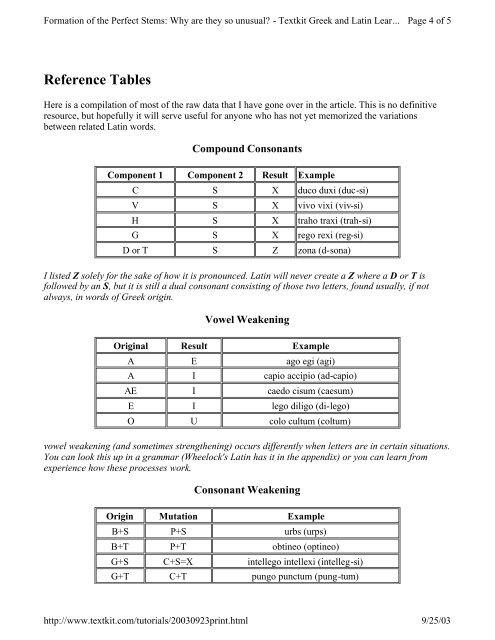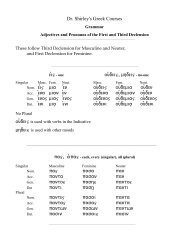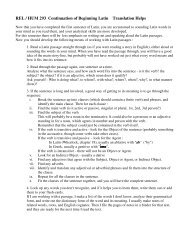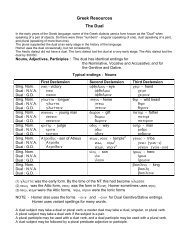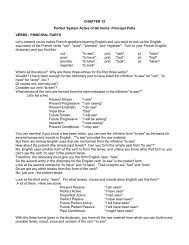Formation of the Perfect Stems: Why are they so unusual?
Formation of the Perfect Stems: Why are they so unusual?
Formation of the Perfect Stems: Why are they so unusual?
Create successful ePaper yourself
Turn your PDF publications into a flip-book with our unique Google optimized e-Paper software.
<strong>Formation</strong> <strong>of</strong> <strong>the</strong> <strong>Perfect</strong> <strong>Stems</strong>: <strong>Why</strong> <strong>are</strong> <strong>the</strong>y <strong>so</strong> <strong>unusual</strong>? - Textkit Greek and Latin Lear...<br />
Reference Tables<br />
Here is a compilation <strong>of</strong> most <strong>of</strong> <strong>the</strong> raw data that I have gone over in <strong>the</strong> article. This is no definitive<br />
re<strong>so</strong>urce, but hopefully it will serve useful for anyone who has not yet memorized <strong>the</strong> variations<br />
between related Latin words.<br />
Compound Con<strong>so</strong>nants<br />
Component 1 Component 2 Result Example<br />
C S X duco duxi (duc-si)<br />
V S X vivo vixi (viv-si)<br />
H S X traho traxi (trah-si)<br />
G S X rego rexi (reg-si)<br />
D or T S Z zona (d-<strong>so</strong>na)<br />
I listed Z <strong>so</strong>lely for <strong>the</strong> sake <strong>of</strong> how it is pronounced. Latin will never create a Z where a D or T is<br />
followed by an S, but it is still a dual con<strong>so</strong>nant consisting <strong>of</strong> those two letters, found usually, if not<br />
always, in words <strong>of</strong> Greek origin.<br />
Vowel Weakening<br />
Original Result Example<br />
A E ago egi (agi)<br />
A I capio accipio (ad-capio)<br />
AE I caedo cisum (caesum)<br />
E I lego diligo (di-lego)<br />
O U colo cultum (coltum)<br />
vowel weakening (and <strong>so</strong>metimes streng<strong>the</strong>ning) occurs differently when letters <strong>are</strong> in certain situations.<br />
You can look this up in a grammar (Wheelock's Latin has it in <strong>the</strong> appendix) or you can learn from<br />
experience how <strong>the</strong>se processes work.<br />
Con<strong>so</strong>nant Weakening<br />
Origin Mutation Example<br />
B+S P+S urbs (urps)<br />
B+T P+T obtineo (optineo)<br />
G+S C+S=X intellego intellexi (intelleg-si)<br />
G+T C+T pungo punctum (pung-tum)<br />
http://www.textkit.com/tutorials/20030923print.html<br />
Page 4 <strong>of</strong> 5<br />
9/25/03


